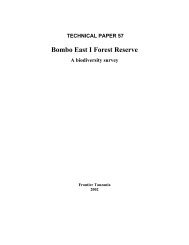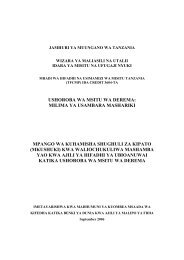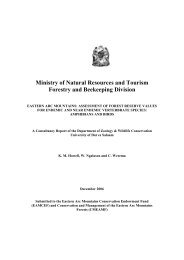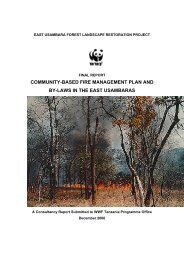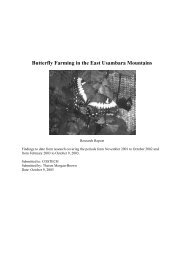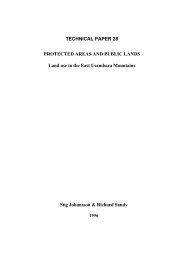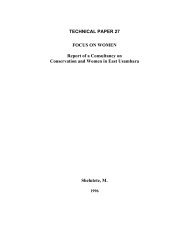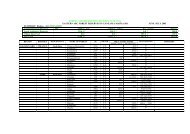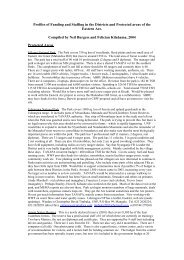Development of Sustainable Forest Use Strategies - Eastern Arc ...
Development of Sustainable Forest Use Strategies - Eastern Arc ...
Development of Sustainable Forest Use Strategies - Eastern Arc ...
You also want an ePaper? Increase the reach of your titles
YUMPU automatically turns print PDFs into web optimized ePapers that Google loves.
Source: Msuya (1998)<br />
collection in East<br />
Usambara.<br />
At one time scientists predicted that P. africana may face extinction in 5 to 10 years<br />
(Scientists, 7 th April, 2000) because <strong>of</strong> intense world demand for it. The plant has a<br />
natural remedy found in its bark that can ease prostate disorders. Although the local<br />
Tanzanian market has not reached alarming rates, chances are that it is going to<br />
increase in the foreseeable future and enhance unsustainable harvesting.<br />
Catha edulis is another threatened species in West Usambara Mountains. There is a<br />
massive collection <strong>of</strong> leaves <strong>of</strong> tree at commercial scale to Kilimanjaro, Arusha,<br />
Manyara, Singida, Tanga and Dar es Salaam. Figure 11 shows leaves-less tree<br />
trunks after complete removal <strong>of</strong> young leaves and small branches as observed at<br />
Kandele Kamp’ala between Magamba and Lukozi villages along Lushoto-Mlalo road.<br />
A detailed study by Msuya (1998) established that out <strong>of</strong> 350 trees, which were<br />
sampled for impact assessment, 308 were either dead or without leaves on their<br />
crowns and branches.<br />
Figure 11: The impact <strong>of</strong> illegal harvesting <strong>of</strong> Catha edulis in West Usambara<br />
In East Usambara, Allanblackia shuhlmannii apart from being used for firewood and<br />
as building materials, seeds from these plants are massively collected and sold (150<br />
sh/Kg) to Unilever project for industrial oil processing. According to the data availed<br />
by Unilever project, in the past three seasons, a total <strong>of</strong> 40, 132 and 200 tones seed<br />
collection was recorded in 2004, 2005 and 2006 respectively, making a total<br />
collection <strong>of</strong> about 372 tones. This is estimated to generate a total <strong>of</strong> about<br />
55,800,000 Tshs to the local communities or about 18,600,000 Tshs per annum. At<br />
the moment there is a high market for Allanblackia seeds in the country which if not<br />
properly evaluated <strong>of</strong> its potential negative impacts may lead into the species being<br />
threatened.<br />
36



